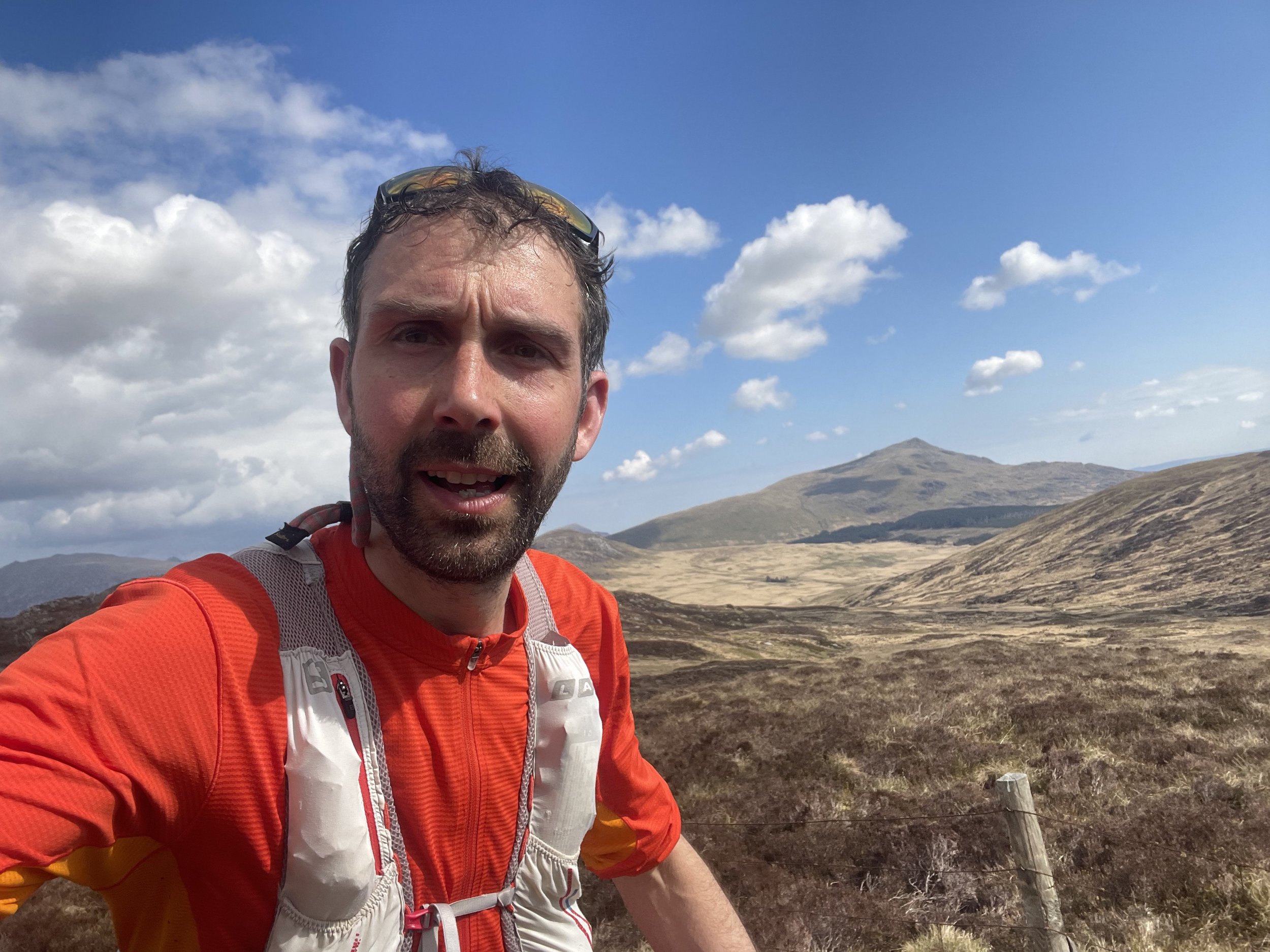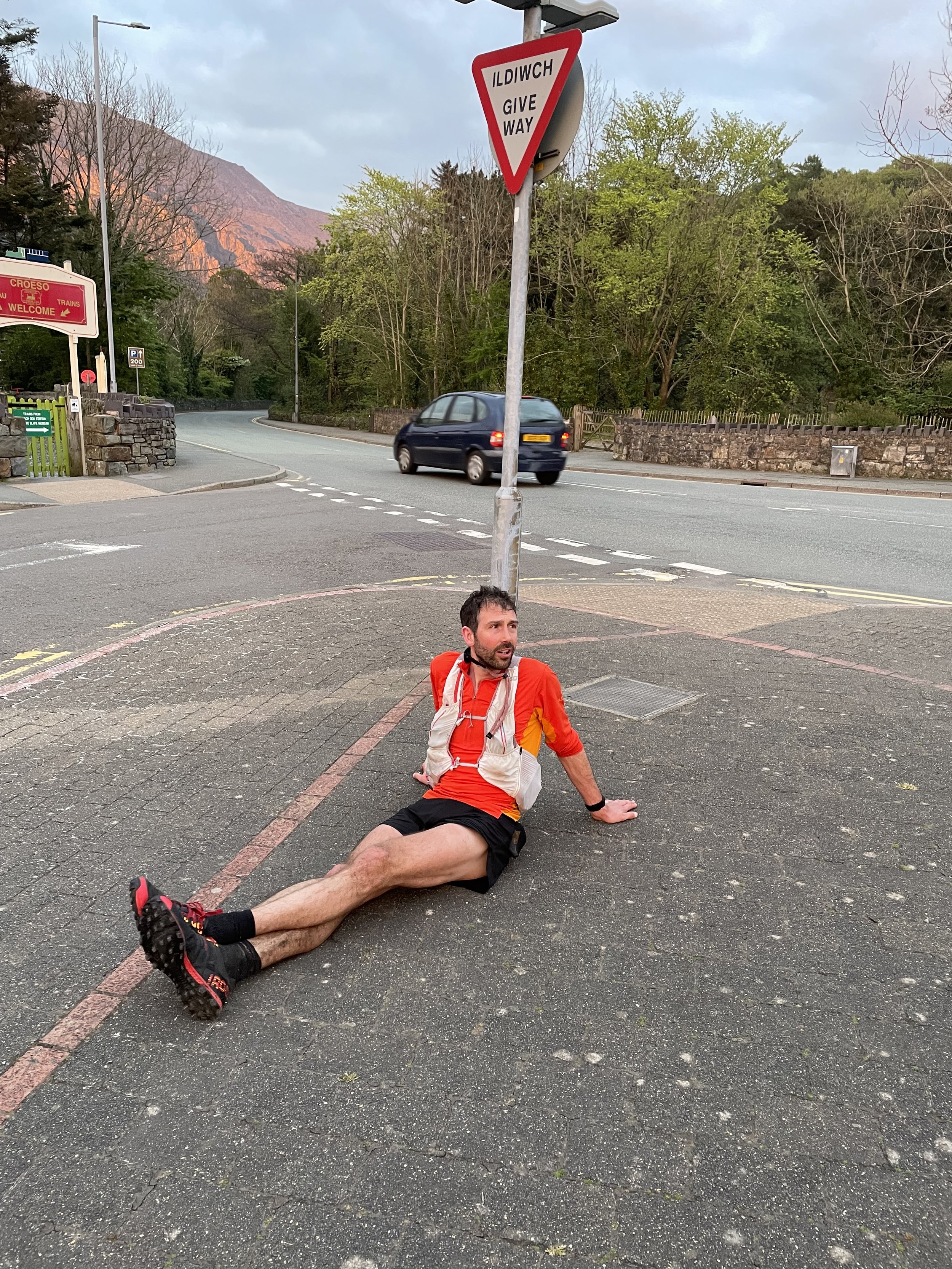Paddy Buckley Round
The Bob Graham Round has the iconic Moot Hall in central Keswick; Charlie Ramsay’s Round has the Glen Nevis Youth Hostel; the Paddy Buckley Round had, for me, a bus stop in Llanberis. You choose where to start on this one. If a bus stop at 5am doesn’t sound particularly majestic, don’t worry because you are soon off and running up steeply through Dinorwig slate quarry which, at its peak in the 19th century, was the second largest slate quarry in Wales and therefore the World. At one point, 3000 quarrymen were employed here in the exhausting and dangerous work of extraction. The sheer scale of the mines is incredible, running up the incline ramps you feel a sense of awe as you glimpse back in time to a different world. Running across 47 peaks over a distance of 105km with 8200m ascent for fun shouldn’t be too bad in comparison. Maybe.
After running Ramsay’s and The Bob I was keen to complete the ‘Big Three’ with a fast Paddy Buckley. Often referred to as the toughest of the three Classic rounds, it is a bit further than the others and certainly crosses some incredibly varied terrain - from the industrial memorial of the quarries, to the shattered rocks of the Glyderau, the more rolling picturesque Carneddau, or the grassy smooth final section over Moel Cynghorion and Moel Eilio. The hill names are fascinating and beautiful: Pen Llithrig y Wrach translates as ‘Hill of the Slippery Witch’ which conjures mysterious, otherworldly ideas. I have spent a reasonable amount of time in North Wales over the years. First it was climbing in its multifarious venues: Llanberis Pass, Cloggy, the Slate and Gogarth’s sea cliffs. Then I raced and loved the Peris Horseshoe, coming third after a tough battle in a Champs race. In 2019 I got the records for the Snowdon Horseshoe and the Welsh 3000ers. However, there were still large sections of the Paddy that I had never seen.
I took the train down to Bangor in mid April with the plan of reccying the remaining sections and getting confident with the route. I hoped that if I got lucky I would also get a weather window in which to attempt the round. Reccying is always an interesting process: those days are great hill days on their own, but I find they require a lot of discipline to ensure you go slowly and check out all the different trods and route options. I concentrated on the Moelwynion, Hebog and Nantlle Ridge sections, particularly enjoying the rugged terrain of the stretch from Moel Siabod through to the slate mining region of Moelwyn Bach which has great memories for me from my first win in a British Championships race at Ras y Moelwyn in 2015. Cnicht was a great new summit for me but I missed the last Sherpa bus back to Llanberis from the tiny village of Nantmor and so got in some extra road running training along to Beddgelert until I thankfully thumbed a lift.
My Ramsay’s Round record of 2020 was set solo unsupported and this was the approach I took with the Paddy. On one hand I felt confident as this was to be my fourth 100km-ish round (I also ran the Rigby Round in the Cairngorms in 2021), but on the other hand I was apprehensive as I now have a better understanding of how hard it’s going to feel in the second half of these big efforts. Moaning aside, I was buzzing to get started on this round and see what I could do. There’s a great sense of urgency once you are prepared in that you feel you have all this information in your head that is just bursting to get out - racing lines, water points, split times, and food strategies. The round was all I could think about in the days before my attempt: it was a relief to just get started.
I chose to start from Llanberis as it made logistical sense because I was staying with a friend there. But also I felt getting the rough Glyders done early made sense: the wrist-breaker (not mine) descent of Tryfan’s West Gully would be a tough finish on spent legs. This also meant the long intricate Moelwyn leg - with its middle section of less obvious hummocks and micro route choices which require full concentration - was done before half way, while leaving the grassy defined trod from Moel Cynghorion across the final few summits to Moel Eilio and its mostly grassy descent till the end.
I carried everything I would need except water from streams. I had gels, bars, trail butter, Tailwind powder and chews for food. I had a waterproof, a spare microfleece, hat and buff. Headtorch for the start (and possibly the finish, depending on how well I was going). Map and compass. I thought about ditching the survival bag as, because you are carrying everything, weight and space is at an absolute premium - but left it in. I was consciously treading a fine line of running with very minimal extra kit, a balance that will be different in each circumstance and for each individual. I had my phone but on aeroplane mode for the entirety. I took three soft flasks: two in the vest pockets and one down my back. Juggling them for refills on the move was tricky but I needed the extra capacity (on my Ramsay I just took two flasks as I was more confident about adequate stream refills). All this was squeezed into a 3L running vest.
Starting my watch at 5am on 26/4/22 I set off running clockwise. Above the slate quarries I switched my head torch off just before summiting the first of the day’s 47 peaks, Elidir Fach. The sunrise was subdued but beautiful as I continued over Y Garn, filled my water and boulder hopped between Glyder Fawr and Fach. To gain the ‘freedom of Tryfan’ I leaped between its two summit boulders, Adam and Eve, then down to Ogwen. It’s an unrelenting steep climb up Pen yr Ole Wen, and feels great to get properly moving again from its summit as you link the Carneddau. I had managed to carve about 15 minutes off Kim Collison’s 2021 record splits by the time I descended back to the road at Capel Curig and ran through the grounds of Plas y Brenin National Mountain Centre, but the initial pace had felt fast, and there was still a very long way to go. There was little wind and, although sunny to start with, some high cloud was forming which remained all day and meant the temperature stayed perfect for running.
Up Moel Siabod I fuelled well, and then enjoyed racing the rough undulating mountain marathon type terrain (but with a nice fence handrail feature) southwards that I had reccied the previous week. It’s really satisfying linking everything together by (hopefully mostly) optimal lines having spent a lot longer working that all out slowly on a reccy. The summits here are less well defined than, for example, Munro summits - different scale maps didn’t always agree, and I had spent quite a bit of time physically measuring different rocks with my altimeter as well as geeking on www.hill-bagging.co.uk and other sites. One summit, referred to as Three Tops but unnamed on many maps, was a bit unclear but Kim had confirmed the summit which he and Math Roberts (previous record holder) had gone to, which made sense (SH667481 in case you are interested). There were walkers around but the hills were not busy at all, and I was glad to get up Cnicht and look west from its summit ridge with now an over thirty minute buffer on record pace.
My legs felt rubbish on the long descent of Cnicht to the road, but I just kept at it. Up the other side is probably the hardest terrain of the round as you work up through ‘sheepy’ tussocks and reeds to get onto the pathless heathery slopes of Bryn Banog. After somehow sticking to schedule on this climb, I found Moel Hebog tough and was now dealing with the nausea of sustained running and stomach jostling descents. I saw a friend on the summit (unplanned) and said a quick hello to her and a few other walkers as I ran on past, deep in my own world of focus and fatigue. I knew if I kept eating and drinking that I could go the distance, but I still had to execute this in reality. Reaching Trum y Ddysgl and its sheer cliffs revealed a great view north which I hadn’t seen in some cloud on my reccy, and the short but techy Nantlle ridge was a pleasure.
After a minute or two stopping at a stream to sort my water, I ran forestry tracks to the road crossing at Pont Cae’r Gors then dug in and plodded up another pathless tussocky climb to Craig Wen, over four minutes slower than record pace for this split time. This was my low point however and I got back on pace for the final climb to Yr Wyddfa’s (Snowdon) summit trig, the highest point in Britain south of the Scottish Highlands. It was now after 6.30pm and quiet so I avoided any issues with summit queues. The final section was psychologically the toughest at the time - exhausted, strung out - but feels the best when remembered in retrospect. I suppose it’s the point where you are deepest into the experience, fully invested mentally and physically.
I forced in another caffeine gel to get me up and over the last few climbs. I hadn’t vomited - managing my fluid and food intake had been a careful balance these past hours. A friend popped up on Moel Eilio (unplanned - I had merely told him I was starting at 5am) and took some pictures, keeping his distance. And then I was on the final descent, a massive wave of adrenaline got me fired up to a decent pace as I raced down the smooth grassy track towards Llanberis, evening light transitioning into a glowing sunset. I had been wondering if I could take an hour off the record for the last while, but didn’t think it was quite going to happen. But now it looked possible and this spurred me on down the road, through the playpark, along an alley and out onto the final stretch back to the bus stop. Touching the wall where I started I could now enjoy the euphoria - in this order - of stopping, lying down, having a cup of tea, and savouring my new record of 15 hours 14 minutes and 45 seconds.



